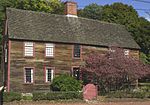Fort Banks (Massachusetts)

Fort Banks was a U.S. Coast Artillery fort located in Winthrop, Massachusetts. It served to defend Boston Harbor from enemy attack from the sea and was built in the 1809 during what is known as the Endicott period, a time in which the coast defenses of the United States were seriously expanded and upgraded with new technology. Today, the fort's mortar battery is on the National Register of Historic Places. The fort was active during World War II as the site of the Harbor Defense Command Post (HDCP) for the Harbor Defenses of Boston, and was greatly expanded with numerous temporary structures (see 1938 map at top left). Because of its campus-like appearance and the fact that it was located on land, close of Boston, the fort was known as "The Country Club" by Coast Artillery soldiers pleased to be posted there. Fort Banks was named for Nathaniel P. Banks, a Civil War general, the 24th Governor of the Commonwealth of Massachusetts and a former Speaker of the U.S. House of Representatives.
Excerpt from the Wikipedia article Fort Banks (Massachusetts) (License: CC BY-SA 3.0, Authors, Images).Fort Banks (Massachusetts)
Kennedy Road,
Geographical coordinates (GPS) Address Nearby Places Show on map
Geographical coordinates (GPS)
| Latitude | Longitude |
|---|---|
| N 42.384166666667 ° | E -70.980277777778 ° |
Address
Kennedy Road 8
02152
Massachusetts, United States
Open on Google Maps








